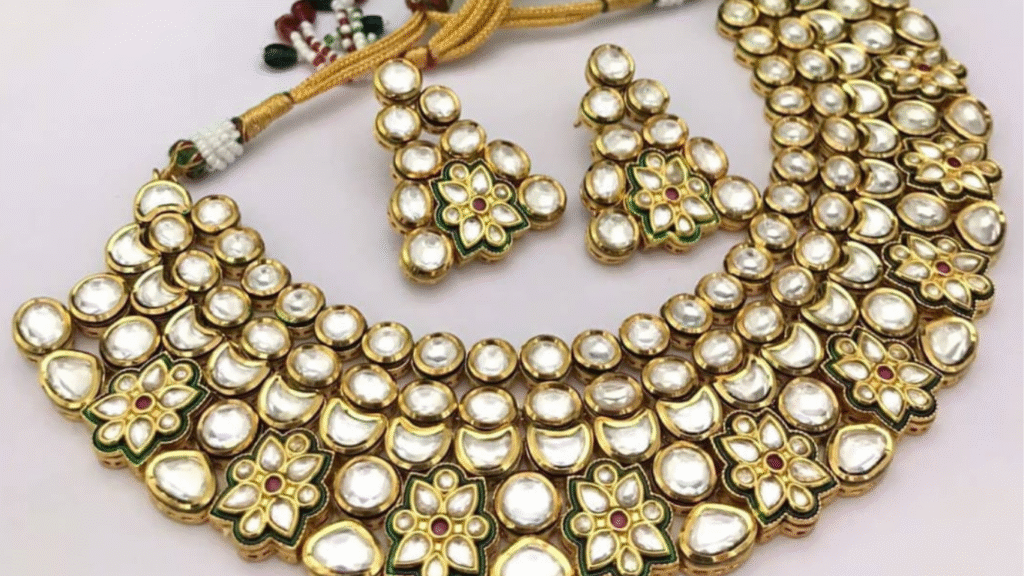Kundan Jewelry : A Timeless Tradition of Royal Craftmanship
Artisans created Kundan jewelry as one of the oldest and royal jewelry styles in India, known for its intricate craftsmanship, rich history, and association with royalty. People originally developed it in Indian cultural heritage and still consider it the first choice for weddings, festivals, and special occasions due to its ornate and artistic design. Kundan jewelry is a type of Artificial jewelry.

Kundan Jewelry History and origin
People believe that Kundan jewelry originated in the royal courts of Rajasthan and Gujarat about 2500 years ago.. During the Mughal period, this art reached its peak When Artisans from Different parts of The Subcontinent Gathered and started developing. This Complex Art. The Word “Kundan” reflects the layer of Extremely Pure Gold used to enclose gems. The Mughal emperors, known for their appreciation of Art and Luxury, played a pivotal role in popularizing Kundan Jewelry. Eventually, Jaipur became the center of This art and Kundan is still famous for craftmanship today
The Making of Kundan jewelry
Creating Kundan jewelry is a painstaking and elaborate Process, Which consists of many Stages and Special Artisans for Every Stage:
1. Ghat (Framework Creation): Ghat process begins with the formation of the original structure or skeleton of jewelry pieces, usually made from Gold or Silver. The structure of this jewelry piece provides the foundation on which the entire design will be built.
2. Padhi (carving of design): After this, Skilled Artisans carved delicate pattern and motifs into the surface of the Framework. This phase makes the base for the location of stones and decorative elements.
3. Excavation (Settings of Gems): In this phase, the artisans carefully set semi-precious and precious gems like ruby, emerald, sapphire, and diamonds into the engraved structure. They place each stone in its designated spot with great precision.
4. Meenakari (Enamel Work): Artisans often adorn Kundan jewelry with Meenakari, a colorful art done on metal. They usually apply it to the reverse side of the piece, giving it a two-sided beauty.
5. Jadai : Artisans perform jadai as an important process in making Kundan jewelry. They gently press high-purity gold foils, known as Kundan, around the stones to secure them firmly in place. This not only protects the stones, but also the piece a rich, shining finish.
6.Polishing and finishing : Finally, the artisan polishes the jewelry to bring out its bright look.Full jewelry is a mixture of traditional beauty and artistic cleverness.
Kundan Jewelry Types
Kundan Jewelry is available in many styles and types to suit various occasions and personality.
Necklace: Perhaps the most popular form of Kundan Jewelry , Kundan Necklace is wide and often associated with matching earrings. Chokers, Rani haars and multi-layer necklaces are some common styles.
Earrings: ‘women’s wear Kundan jhumke and chandbalis with or without a necklace.
Mang tikas: People consider the Mang tika necessary in the bride’s makeup and often make it closely with kundan stones.
Bangles and Bracelets: They add a touch og elegance and tradition to the wrist. They can be plain or heavy herbs with stone.
Rings and Hathphools: People wear large and royal Kundan rings as statement pieces.. Hathfool (hand chain) combines the ring and bracelet, forming a dramatic bride’s accessory.
Anklets and Waistband: Although less common today, traditional kundan anklets and Waistband are a great option for special occasions
Cultural Significance:
Kundan jewelry not only decorates but also carries deep cultural and symbolic significance. People usually wear it during festivals and auspicious occasions such as weddings, engagements, Diwali, and Karva Chauth.
In many Indian families, Kundan set are heirlooms, passed from one generations to another, Which are a symbol of Tradition and Prosperity. People consider Kundan jewelry auspicious for the bride and a sign of prosperity. Artisans craft each piece with love and precision, often customizing it to reflect family traditions and personal choices.
Modern Trends
In today’s fashion world, Kundan Jewelry has successfully maintained its attraction for contemporary taste. Designers now experiment with light Kundan sets, fusion styles, which are the minimum version for modern brides and party-goals by combining Kundan with pearl or Polki.
Bollywood celebrities and fashion influencers also favor Kundan jewelry, often wearing traditional pieces at red carpet events, film promotions, and weddings. Their choice has helped rejuvenate interest among young audiences, and they use Kundan as a bridge between tradition and modern trends.
Kundan vs Polki vs Jadau
Many people confuse kundan, polki, and jadau, but the difference is clear.
Kundan:Artisans use a layer of pure gold to set gems in the frame.
Polki: polki uses uncut, naturally mined diamonds in their raw form, making Polki jewelry more expensive than kundan.
Jadau:The Mughals originally introduced the technique used to prepare both Kundan and Polki jewelry. This involves embedding stones in a gold frame without using a solder.
Care and Maintenance
Kundan jewelry, due to its delicate construction and use of natural stones, require proper care: Storage: Store Kundan pieces in a soft cloth or velvet box to prevent scratches and tarnish.
Cleanliness: Do not use chemical cleaners, Instead gently wipe with light cloth. For a deep clean, consult a professional jeweler.
Caution: Protect from contact with water, perfume or lotion, as they can cause harmful and damage to the Kundan setting.
Kundan Jewelry is not just one ornament, but is a symbol of India’s rich cultural and artistic heritage. its royal glow, fine design and traditional importance make Kundan Jewelry an invaluable gem in every woman’s collection. Whether it is the bride of the day of wedding or a woman decorated on a festival, Kundan Jewelry is always to embody grace, elegance and tradition.

